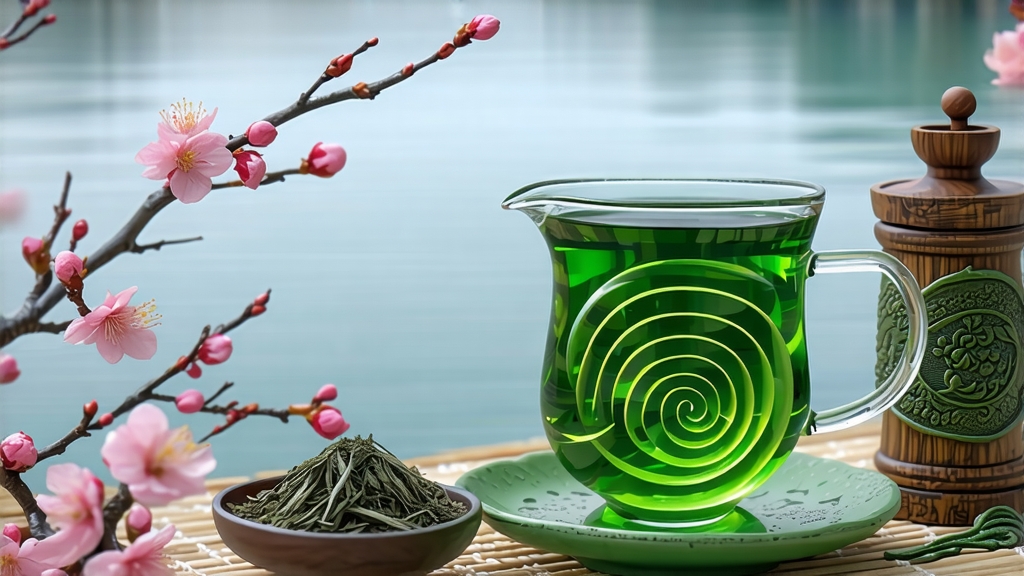
Tucked between the mist-laden hills of Dongting Mountain and the shimmering waters of Lake Tai in Jiangsu Province, Biluochun—literally “Green Snail Spring”—has captivated Chinese emperors, poets, and tea lovers for more than a thousand years. To the uninitiated, the name evokes a tiny green snail; to the connoisseur, it conjures an aroma so fragrant that locals once called it “Scary Fragrance” (Xia Sha Ren Xiang) because it perfumed entire streets when women in the village began the spring pan-firing. Today, this celebrated green tea remains one of China’s Ten Famous Teas, yet outside the Middle Kingdom it is still overshadowed by Dragon Well or Longjing. This essay invites international drinkers to discover Biluochun’s history, micro-terroirs, painstaking craft, and the quiet ritual that unlocks its orchid-sweet liquor.
Historical roots
The first written record appears in the Tang Dynasty (618-907) “Tea Canon,” but the tea gained imperial status only in 1699 when the Kangxi Emperor tasted it on his southern inspection tour. Struck by its curled shape and heady aroma, he rechristened it “Biluochun,” combining “bi” (green), “luo” (spiral), and “chun” (spring). Court annals note that 16 kilograms were immediately reserved for the Forbidden City, while local monks were ordered to carve terraces on Dongting’s rocky slopes to increase production. European travelers of the 19th century carried small tin chests of the tea to Paris and London, where it was served in porcelain gaiwans as “Pi Lo Chun” and praised in ladies’ gazettes for its “delicate bouquet of water-chestnut blossom.”
Micro-terroir and cultivars
Lake Tai acts as a vast heat reservoir, shrouting the Dongting and Xishan peninsulas in evaporative mist that filters sunlight into a soft, diffused glow. The soil is a friable mix of weathered granite and lake sediment, rich in quartz and slightly acidic (pH 5.0–5.5). Within this microclimate, two traditional cultivars dominate:
• Dongting Small-Leaf群体种, an indigenous shrub with tiny, thick leaves that accumulate amino acids under cool spring nights.
• Fuding Da-Bai Hao, a downy cultivar borrowed from white-tea country and grafted onto Dongting rootstock to add velvet sweetness.
Recent clonal selections such as “Biluochun 1” and “Biluochun 2” yield higher bud density, but purists insist the old mixed population bushes—interplanted with apricot, peach, and loquat—absorb floral volatiles that no breeding program can replicate.
Harvest calendar
The picking window opens when lake mist still hangs at knee height and the morning thermometer hovers between 12 °C and 15 °C. Only the unopened bud plus the adjacent leaf, no longer than 2.5 cm and still tincted with purple, qualify as “Grade One.” A skilled picker gathers just 200 grams per hour, bending repeatedly among knee-high bushes. By 9 a.m. the sun burns off the mist; picking stops to prevent oxidative damage. In the best years, frost on Qingming Day shortens the harvest to five frantic days, making top-grade Biluochun rarer than pre-spring Dragon Well.
Craft: the nine motions
Within four hours of plucking, the fragile leaves undergo a nine-step transformation that has changed little since Kangxi’s era.
- Withering on bamboo trays for 30 minutes reduces surface moisture and coaxes a faint grassy note toward orchid.
- “Shaqing” or kill-green is done in a cast-iron wok heated to 180 °C. The tea master tosses 250 g of leaves with both palms, using a wrist-flick that sends them spiraling through the air like green fireworks. Temperature is judged solely by the sizzling sound—too loud and the enzymes survive; too soft and the aroma flattens.
- Rolling while still hot compresses cells and initiates the signature curl. The maker alternates between light stroking and rapid twisting, curling 80 % of the leaves into tight spirals within six minutes.
- First drying at 70 °C reduces moisture to 30 % and sets the curl.
5